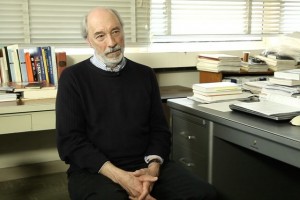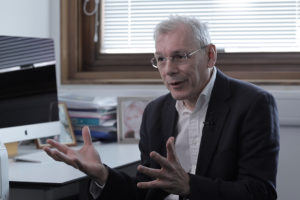Fundamental Interactions
Physicist Jonathan Butterworth on the term ‘fundamental’, the forces of the Standard model and why gravity is ...

Ioannis Ieropoulos is Professor of Bioenergy and Self-sustainable Systems at Bristol Robotics Laboratory. Serious Science has asked Prof. Ieropoulos to speak on the subject of microbial fuel cells – a novel technology that allows to receive electricity from the treatment of biological waste.
What is your laboratory currently working on?
We are a research center within a research laboratory and there is a wide range of work done in the laboratory of which we are part. So, how to make an introduction, because it’s a bit of a weird relationship between sanitation and robotics, and there is a reason for that. Our center is known as the Bristol bioenergy center, and we are interested in bioenergy in general, how we can utilize waste matter and turn it into useful electricity. That is a very brief description of the work we do. We are a part of a robotics laboratory, with a lot of excellent activity in the many different areas and where these can be implemented, including energy autonomy and self-sustainable systems. So there you can see the synergy between bioenergy and self-sustainability and that’s primarily our work. We are developing systems, which produce electricity from waste, and which can be self-sustainable in a systems engineering manner.
From the page of your laboratory on the website I gather that the main object of your research is microbial fuel cells. Can you please tell us more about them? How they work, how they function and how you develop them?
Absolutely. The core technology we are developing is indeed the microbial fuel cell technology. It is a technology which has got a long-standing history of more than a century, since the first paper was published in the field. It’s a technology that we are pushing really hard in terms of performance for electricity generation. The way it works – it’s effectively an energy transducer with two compartments that are separated by a semi-permeable barrier. Inside one compartment we take bacteria from natural sources, from the natural environment, and we put them in that chamber, and we use the other one, the second chamber, as the counter half-cell for completing the reactions. The chamber which takes the bacteria is known as “the anode”. And if we look at a battery, it would be the equivalent of the negative terminal of the battery. We call the other chamber “the cathode”, and it would be the equivalent of the positive terminal of a battery. Inside the anode, the bacteria are fed with a carbon energy source they require for growth and maintenance. But because they are in that chamber, which contains an electrode, their only way of survival is to break down the organic substrate we give them as food and anaerobically respire via that electrode. As the unique feature of the microbial fuel cell, the microbes they’re not doing anything different to what they normally do when they’re in their natural habitat, however, inside the microbial fuel cell their anaerobic respiration results in electrons flowing from the inside of the bacterium cell all the way to the outside and onto the electrode. That electrode in the anode chamber, the negative electrode, is connected via a circuit or a piece of wire to the cathode electrode. And this form the path for electrons to flow. Once we have electrons flowing from the negative electrode through the wire to the positive electrode, then this is the current, the electrical current generated by the device. That’s the principle of operation.
What are the advantages of microbial fuel cells over the current energy sources that we have?
This is a very interesting question. The current sources that we have, the conventional sources that we have obviously had centuries of development and this is a true technological development, not simply R & D. And they are capable of generating the kilowatts, the megawatts, the gigawatts that we are using today. The microbial fuel cell, as a unit, as a technological unit, is smaller than a pack of chewing gums, just to give you an example. And it’s at the other end of the spectrum – it’s a technology producing microwatts or miliwatts. So we are at the stage where we are trying to address the challenge of scaling it up, so that microwatts and miliwatts can become kilowatts or (why not?) megawatts, as we would one day use it. That is one of the main differences with current conventional technologies. The unique characteristic of microbial fuel cells is because of the fact that they are using, utilizing the microbial metabolism, it is the only technology that can generate electricity directly from the breakdown of waste, material we throw in the bin or allow to go down the drain.
And what about the environment? Will it be better for the environment if we use these microbial fuel cells and not our current energy generating technologies?
That is an excellent question, because the answer to it is yes, with a capital “y”, for the simple reason that when the microbes break down the substrate we feed them for their growth and maintenance, which results in us receiving electricity, they are effectively treating that waste in a similar way to how waste treatment plants are performing at municipal level. This is one of the strong points of the microbial fuel cell technology; it’s the fact that they treat the waste or waste-water and the by-product of this treatment is electricity we collect and can use. So for the environment, going back to your question, it will be a much better and very positive way forward for the humankind if microbial fuel cells were distributed more widely, because wherever they are placed the output of the microbial fuel cells, this is the liquid output, is a cleaner waste than the one that went in in the first place, plus the electricity.
What would be the advantages of this technology over the other alternative energy technologies, such as solar power, artificial photosynthesis and others?
Some of the characteristics that would separate these technologies that you’ve mentioned would be the fact that the microbial fuel cells can work day or night, they can work over a wide range of temperatures and over a wide range of environmental conditions. So this is potentially a technology that can work overground, underground, under water, where it is dark and humid, or where the sun is shining. So these are some of the characteristics, because, as I’ve mentioned before, the technology which is exploiting biological agents, it’s exploiting bacteria, which are naturally occurring, it is therefore a technology that can be applied across a wide range of environmental conditions, and thus it is not subject to solar radiation or a specific temperature range, it is a technology that can operate across those vastly different conditions.
On what stage of development is the field of MFC research now?
When it comes to development of MFC for urinals or toilets we are at the stage where we are performing field trials to evaluate the technology outside of the laboratory and be able to assess its feasibility. We are pushing it for commercial exploitation, so we are on the verge of commercial exploitation for the toilet industry. Field trials that we’ve performed: one has been the ‘Pee-Power’ urinal on the university premises – on campus outside the student union bar – which is a trial we performed between March and May this year, and we have restarted in September this year; and the second is the ‘Pee-Power’ urinal we had been running during the Glastonbury Music Festival for the period of time that the festival was running. Both trials have given us different types of information, because the population of the music festival has been much larger compared to the student population and the throughput for using our urinal has been quite different. So we are in the process of gathering all this information and correlating that together, so that we can understand how potential commercial exploitation may happen.
What is the future of the field?
We’d like to envisage the future where these microbial fuel cells have been implemented, they have been integrated with existing processes. They are not necessarily an antagonistic technology, they are more of a complementary technology which can add value to existing processes, but it can also be introduced in different places, different parts of the society where currently we have nothing to have in return in terms of energy from waste. So we envisage MFC being buried in the back garden and taking the domestic waste water and turning it into useful energy, we envisage having MFC as portable chargers for mobile phones or other electronic devices. We also envisage MFC perhaps being wearable devices on smart textiles, taking advantage of human waste directly and producing energy very locally, but being available for emergency purposes.
Can it eventually become the main energy source?
The efficiency of MFC is something that we are probably operating at much higher levels than other technologies, simply because of how efficient the microbial engine is. The challenge is more of an engineering design challenge – how to scale up the system and maintain that high efficiency, so that that all the energy in waste matter, in waste water, in urine, in black water can be turned into electricity. If that happens then wastewater treatment plants can become energy-neutral and potentially energy-positive, in the sense that they could be efficient in producing energy from the treatment of waste. And more energy than what they need to run the waste water treatment process. So as a kind of a phased step-by-step approach – that’s how we would see the technology going, it’s difficult to project very much further and say that this technology can replace everything, that would be a very general claim, but there is potential for that technology to reach out to these niche areas where currently we haven’t got anything. It would be risky for me to say that it can replace everything unless we have done the work and we have proved it.
If we use MFC on a large scale, will we have enough waste to generate energy to sustain, for example, an energy supply for a house?
As things stand, I think, it’s fair to say that we have enough waste and more than the planet can handle – the way that the modern society has evolved and the way that the municipal solid waste is accumulating in all the countries of the developed world. So in terms of waste management this is potentially a solution to the big problem of landfill waste accumulation and waste water production from domestic single-household production to a larger, community level. So it is not a question of waste, whether the society will generate sufficient waste or not, it is more of a question of how we tailor the technology to take advantage or to utilize what we generate as a waste as a modern society.

Physicist Jonathan Butterworth on the term ‘fundamental’, the forces of the Standard model and why gravity is ...

Physicist Frank Taylor on the Higgs boson, supersymmetry, and physics beyond the Standard Model

Astrostatistician Alan Heavens on general relativity, how lensing can be used to observe dark matter and wheth...